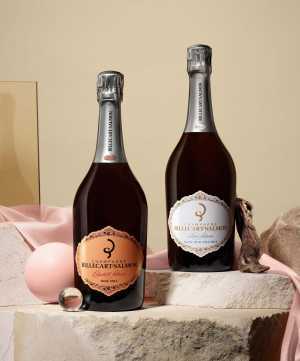Billecart-Salmon is a rare breed, as one of the few legacy champagne houses still family-owned and run. “We are the 200-year-old turtle,” quips Billecart-Salmon’s CEO Mathieu Roland-Billecart.
Mathieu explains that a transgenerational approach to making champagne means you’re accountable for what you produce and pass on.
There are decades of experience to call upon in times of tumult, too – he can give his 101-year-old great-uncle a call when encountering a growing season he’s unfamiliar with.
Despite being born into the business, Mathieu was not destined to run it. Previously working for 15 years in mergers and acquisitions for Ernst & Young in London, the invitation from his 95-year-old grandfather to take the reins was flattering but unexpected.
In the same way that cross-pollination is crucial for a flower to thrive, the family business is not run in a vacuum. The eight-person-strong tasting committee comprises four family members alongside four non-family, including past and present cellar masters.

Billecart-Salmon Elisabeth Salmon Rosé 2012 and Louis Salmon Blanc de Blancs 2012
Champagne making isn’t something you go into if you’re seeking out a hit of instant gratification, and the tasting committee are entrusted with the titanic task of blind-tasting every vinified plot at every stage of its evolution.
“From December to late March, we’re tasting 500 wines per month. I have to taste more than drink – otherwise, I would be dead!” laughs Mathieu. This process may be arduous, but it’s crucial to ensure the blends of vins clairs (base wines) for all the cuvées maintain a consistent house style through the years despite the wax and wane of vintages.
An empty glass is the greatest compliment, and to achieve this, Billecart-Salmon rests on the basic principle that if you do the small things right every day while no one is watching, the large, important ones will take care of themselves.
This starts with its 300 hectares of vineyards spread across Montagne de Reims, Vallée de la Marne and Côte des Blancs, responsible for growing pinot noir, pinot meunier and chardonnay, respectively.
Billecart-Salmon owns one-third, another third are managed under its viticulture management contracts, and the final third of grapes are purchased from long-time grower partners. Billecart-Salmon will always buy grapes over pre-made wine.
If you’re into bulky champagnes with hefty percentages of oak-vinified wines, then Billecart-Salmon is not for you. Slower fermentation of three-to-four weeks over two-to-three days at low temperatures not exceeding 13°C means its champagnes are revered for freshness, tension and a backbone of acidity.
You can’t cheat with time, so Billecart-Salmon regularly exceeds the minimum periods of 12 months and three years outlined for ageing on the lees for non-vintages and vintages. Many of the vintage cuvées are aged on the lees for decades in order to guarantee longevity.
Despite being a relatively small producer, making roughly 2m bottles per year (some of the largest houses produce 30m bottles), Billecart-Salmon has been quietly accumulating a substantial, loyal fan base over the years, which became particularly apparent during the pandemic.
From 2019-2020, they were among the few producers in Champagne to maintain similar sales compared to pre-Covid despite the complete shutdown of hospitality.
As Mathieu explains, people who liked to drink Billecart-Salmon in restaurants but couldn’t get hold of it reached out to the champagne house to buy directly. While others were on furlough, they worked during lockdown, with Mathieu operating as both CEO and receptionist.
Leif Carlsson
Leif Carlsson
This year, Billecart-Salmon exemplified its strong history and exceptional wines with the release of two 2012 vintages, paying tribute to the house’s founders in the Salmon family.
A vintage wine is a rare label given to a drop made during a particularly good year, and 2012 was just that, a year of healthy harvest yielding grapes rich in sugar with a good dose of balancing acidity.
Cuvée Elisabeth Salmon 2012 – named after the house’s cofounder – is a stunning, elegant rosé champagne that personifies Billecart-Salmon’s thoughtful approach to winemaking.
Cuvée Louis Salmon 2012, meanwhile, is named after Elisabeth’s brother and the House’s first chief winemaker – and is a full-bodied, creamy blanc de blancs made from the finest chardonnay from La Côte des Blancs.
From the house’s beginnings in 1818, to its continued family-run operation today, Billecart-Salmon is proving that blood really is thicker than champagne.
For more information, see champagne-billecart.fr

